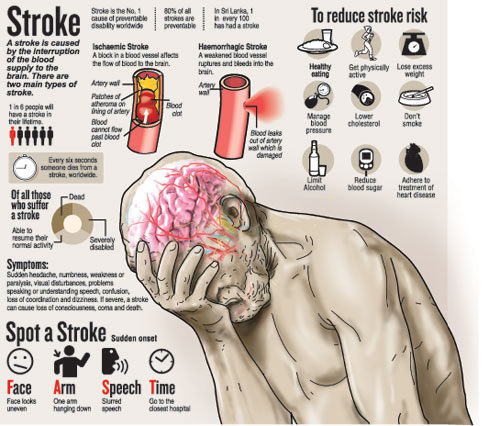News
A helping hand for stroke victims to get up again
“Let’s get up again after a stroke,” are the encouraging words being given out by several Consultant Neurologists echoing the theme of ‘Up again after stroke’ of World Stroke Day which falls tomorrow (October 29).
Reiterating that it is important for stroke sufferers to overcome disability which would keep them down and get back into society, they say that this is what the Stroke Support Organisation (SSO) is striving to achieve.
Guided by several Consultant Neurologists such as Dr. Padma Gunaratne, Dr. Arjuna Fernando and Dr. Gamini Pathirana and backed by different types of therapists, the SSO is working hard to get stroke victims back on their feet to near previous levels of function.
Yesterday, as is usual on the last Saturday of the month, the members of the SSO met on the First Floor of the Epilepsy Building of the National Hospital of Sri Lanka (NHSL) to hear two short talks by Dr. Pathirana and Occupational Therapist Lasanthi Siriwardhana, before targeting the visitors of patients coming to the hospital in the afternoon.
Carrying placards and banners…….no they were not part of a protest, but a core group bent on spreading the message about stroke – that it is preventable and also treatable. Just before this ‘demonstration’ near the NHSL’s neurotrauma entrance, the SSO also held a short walk around the NHSL to commemorate World Stroke Day, in a programme from 9 a.m. to 12 noon.
The demonstrators focused on how a healthy diet, exercise and giving up smoking can prevent a stroke.
A first in Sri Lanka, although other countries have such networks for stroke support, the SSO is a platform for stroke survivors to communicate with each other, facilitate further rehabilitation, build awareness and help carers and family of stroke survivors to have a small break.
Very willingly, the President of the SSO, Ven. Bambarande Rahula Thera, 57, of the Jethavana Viharaya in Colombo 14, talks of how some of the SSO members including him have been coaxed and encouraged to get out of their wheelchairs.
Five years ago he suffered a stroke and now he walks with the help of a basthama (walking stick), he says, pointing out that the SSO provides a “loku prabodayak” (rejuvenation) to them.
“It has given us strength to will our minds to make us get up. Thaniwela ne (we are not alone),” he adds, appreciating all the efforts put in by Dr. Gunaratne to launch this organisation.
In the limelight yesterday was 63-year-old H. Anoma Sandanayake from Wadduwa, who gave a talk on what is stroke and how to overcome it, while advising people on how to prevent a stroke.
“The SSO has carried out many activities including outings which make us forget our situation. There is a lot of dayawa and karunawa (kindness) and we have changed our attitude towards stroke,” says Anoma.
Formed about a year ago, the SSO which works in coordination with the National Stroke Association of Sri Lanka, has more than 100 members, mostly patients who have survived stroke with a disability and their family members.
“The SSO is patient-based and the multi-disciplinary stroke care team is giving it a hand to carry out its objectives,” says Dr. Pathirana.
He details the objectives of the SSO as:
- Providing a platform for stroke patients to socialize;
- Educating the public on the prevention aspects of stroke;
- How best to improve prevention measures against stroke and also stroke care in the community itself; and
- How to improve the wellbeing not only of the stroke patient but also of his/her carer.
- Dr. Arjuna Fernando too reiterates that stroke is preventable, but if you get a stroke it is treatable.
“What we would like to keep repeating is that people need to be able to recognize the signs and symptoms of stroke and bring the person to hospital immediately,” he says, adding that any deficit (loss) of function experienced should be identified immediately.
Even if someone has a TIA (Transient Ischaemic Attack) which passes, that person needs to come to hospital because a full-blown stroke may follow suit. So dealing with a TIA will help prevent a stroke, adds Dr. Fernando.
Meanwhile, the National Stroke Association of Sri Lanka has conducted many workshops on stroke for healthcare personnel across the country.
| Heed these red alerts | |
| Stroke is a medical emergency and if anyone is spotted with ‘FAST’ – ‘Face, Arm, Speech’, then it is ‘Time’ (see graphic) to rush that person to hospital.Outcomes improve drastically with admission to a specialized stroke unit, access to the best professional care, usage of best-practice treatment such as clot-busting drugs and mechanical clot-retrieval and with rehabilitation as a critical step in the treatment process, it is learnt. The statistics on stroke send chills down the spine:
| |

